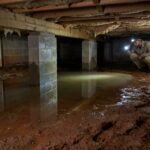Essential Guide to Foundation Repair: Preventing Costly Damage to Your Home
When it comes to homeownership, the foundation of your house is one of those things you never think about until something goes wrong. Much like that forgotten gym membership or your cousin’s questionable taste in tattoos, foundations often stay out of sight and, unfortunately, out of mind. However, when issues arise, it can lead to a cascade of problems that can be as alarming as finding out your car’s check engine light has been on for months. In this essential guide to foundation repair, we’ll cover everything you need to know to keep your home standing tall, prevent costly damages, and perhaps even save yourself from a few sleepless nights.
Understanding Foundation Issues
To tackle foundation repair effectively, it’s crucial to understand what might be causing your woes. Foundations are typically constructed from concrete, brick, or stone, serving as the supporting base of your home. Over time, various factors may lead to problems, including:
1. **Soil Movement**: The soil beneath and around your foundation can shift due to moisture changes, freeze-thaw cycles, or the settling of the ground. This movement can create pressure on your foundation, resulting in cracks and instability.
2. **Water Damage**: Water is the enemy of foundations. Excess moisture can erode soil and lead to hydrostatic pressure against the walls of your basement or crawlspace. Just like how your pet hamster can turn a little water bowl into a swimming pool, too much rain can cause serious foundation issues.
3. **Poor Drainage**: If your property doesn’t have proper drainage, water can pool around your foundation, exacerbating soil movement and leading to structural problems. It’s crucial to ensure that gutters, downspouts, and grading are channeling water away from your home.
4. **Tree Roots**: While trees add beauty to your landscape, their roots can wreak havoc on your foundation. They seek moisture, which can lead to soil displacement and create uneven settling of your home’s foundation. Remember, not every nature-loving roommate is harmless!
Signs Your Foundation Needs Repair
You don’t need to be a structural engineer to spot the warning signs of foundation trouble. Here are some classic indicators that your home might need immediate attention:
– **Cracks in Walls**: Vertical cracks in interior walls or ceilings can indicate that your foundation is shifting. Horizontal cracks, especially in basements, should raise red flags—much like finding out your favorite movie is being remade poorly.
– **Doors and Windows Not Closing Properly**: If your doors or windows are suddenly getting stubborn, they might be telling you that your foundation has shifted and changed the shape of your frame.
– **Uneven Floors**: If you find yourself playing a game of “does this floor look slanted to you?” it’s time to investigate. Uneven floors can be a sign of significant foundation problems.
– **Bowing or Leaning Walls**: If your walls look more like ancient Roman ruins than a straight-edged masterpiece, you may have a serious issue at hand.
– **Moisture in the Basement or Crawl Space**: A damp environment isn’t just uncomfortable—it’s also an invitation for mold and additional structural damage.
The Importance of Early Detection
Ignoring foundation issues is akin to ignoring that odd noise coming from your car’s engine. Eventually, what starts as a minor annoyance can escalate into a costly repair job. Early detection not only saves you money but also ensures the overall health and safety of your home. It’s always better to address the problem while it’s still small—think of it as attending to a hangnail before it becomes an emergency trip to the doctor.
Foundation Repair Methods
Once you’ve identified that your foundation needs some TLC, the next step is deciding on the best method of repair. Fortunately, there are several effective techniques, tailored to specific issues:
1. **Piering**: This method involves drives steel or concrete piers deep into stable soil to lift and support the foundation. It’s like giving your house a sturdy pair of stilts, so it can stand tall above the shifting ground below.
2. **Slabjacking**: For homes with concrete slabs, slabjacking raises the sunken areas by injecting a specialized mixture under the slab. Think of it as giving your foundation a gentle boost out of its funk.
3. **Wall Anchors**: For bowing walls, wall anchors provide support by connecting the wall to stable soil outside the home. This can help stabilize and straighten out those wayward walls.
4. **Drainage Solutions**: Sometimes, the best solution to foundation problems isn’t fixing the foundation itself but addressing the underlying drainage issues. This might include installing French drains, sump pumps, or improving gutter systems.
5. **Vapor Barriers**: For crawl spaces, a vapor barrier helps regulate moisture levels and protect the foundation from water damage. It’s like putting your home on a diet, cutting out all that extra moisture!
Choosing a Foundation Repair Contractor
Once you’re ready to take action, finding the right contractor is essential. This is not the time to go on a scavenger hunt for the cheapest options. You want experienced professionals who will do the job correctly. Here are some tips for selecting the right choice:
– **Check Credentials**: Ensure the contractor is licensed and insured. Ask for references and read reviews to get a sense of their reliability.
– **Get Multiple Estimates**: Don’t settle for the first estimate; get at least three. This gives you a range of options and insights into what the project should cost.
– **Ask About Experience**: Inquire how long the contractor has been in business and if they have dealt with similar issues. Experience matters—just like knowing the best route to avoid traffic.
– **Evaluate Communication**: Choose a contractor who communicates clearly and promptly. This is a good sign they’ll be professional throughout the process, keeping you informed every step of the way.
Preventative Measures to Protect Your Foundation
Once repairs are made, it’s vital to take proactive measures to prevent future issues and safeguard your foundation. Here are some strategies:
1. **Maintain Proper Drainage**: Regularly clean gutters and downspouts, ensuring water flows away from the foundation. Divert any surface runoff with grading and drainage systems to keep your home dry.
2. **Monitor Moisture Levels**: Keep an eye on the moisture around your foundation. If you live in an area prone to droughts or floods, consider investing in a moisture control system that can help manage these fluctuations.
3. **Plant Strategically**: If you have trees near your home, plant them at a safe distance from the foundation to minimize root intrusion. Opt for smaller plants that won’t disturb the soil around your base.
4. **Inspect Regularly**: Make it a habit to regularly inspect your home for signs of foundation trouble. Catching issues early can save you a lot of headaches later on.
5. **Invest in Landscaping**: Creating a positive slope away from your home can help water drain effectively. Consider landscaping solutions that complement your home’s structure.
Conclusion
Your home’s foundation is a critical component that deserves attention and care. By understanding potential issues, recognizing signs of trouble early, and choosing the right repair methods, you can keep your home safe and sound. Just picture your home sitting proudly on a solid foundation—no cracks, no tilting walls, and certainly no water pooling in inappropriate places! Proactive measures alongside timely repairs will ensure that your house remains a comfortable, stable sanctuary for years to come. So, roll up your sleeves and give that foundation the love it deserves—you’ll thank yourself later!


